Encourage your students to experiment with paint and paper and you’ll be able to watch their creativity fly, says Robert Watts...
One hundred years ago, the role of painting underwent a huge change. With the increasingly widespread use of photography, the pressure on artists to record the visual world was lifted and artists such as Wassily Kandinsky and Joan Miró began to experiment with abstraction. These artists embraced the notion that paint was a material that couldn’t always be controlled, that it could have a life of its own, that it could speak for itself.
As a lecturer in art education, I’ve often reflected on the changes in children’s artwork as they grow older. Essentially, children make the same journey as artists like Kandinsky, but in the opposite direction. They begin by unselfconsciously exploring mark-making with crayons and paints, then progress to trying to represent the visual world accurately as possible, to wanting to control their materials, to get them to do exactly what they want them to do. This can be a difficult and frustrating process, and by the end of primary school many children have become less interested in art, less confident in their artistic abilities and less inclined to take risks with their artwork.
This project aims to provide inspiration and support for teachers who want their children to remain engaged with the process of painting and to retain their enthusiasm and sense of adventure with paint. It features advice on planning and organising painting lessons, details of a number of practical, engaging activities and suggestions for supporting children’s learning in the classroom. Through experimenting with creating a range of abstract compositions children will be encouraged to embrace the fact that paint can’t always be controlled, and to let each of their paintings develop a life of its own.
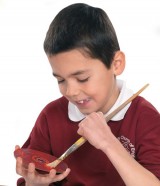 Whatever the age of the children, the way a lesson or activity is planned and presented will have a decisive effect on its outcomes, and as teachers we often have clear ideas about the outcomes we want to see in the classroom. In turn, children become adept at ‘guessing what’s in the teacher’s head’ and in between, opportunities for originality can become restricted.
Whatever the age of the children, the way a lesson or activity is planned and presented will have a decisive effect on its outcomes, and as teachers we often have clear ideas about the outcomes we want to see in the classroom. In turn, children become adept at ‘guessing what’s in the teacher’s head’ and in between, opportunities for originality can become restricted.
Try picturing a gallery in which all the artworks displayed were of an identical size: they wouldn’t hold your attention for long. If you begin a lesson by providing the class with 30 sheets of white A4 paper, there’s a real danger that much of the work generated during the lesson will look the same. Try to encourage individuality in art lessons by ensuring that children are offered choices. Offering a choice of materials, of scale on which to work and whether to work as individuals, in pairs or in groups will not only broaden the range of outcomes from children but also give them a stronger sense of ownership of the process.
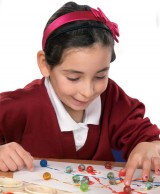 One way to inspire children to experiment is to share with them some examples of work by abstract painters, and a huge range of examples can be found online. A search for paintings by Kandinsky or Miró, or other artists such as Paul Klee, Patrick Heron, Gillian Ayres or Fiona Rae will quickly locate a selection of images that will demonstrate to children that there are endless ways to experiment with paint. Even better, a visit to a museum or gallery would offer children opportunities to appreciate not only the scale of the paintings and their textured surfaces but also to explore their preferences for one artist or artwork over another.
One way to inspire children to experiment is to share with them some examples of work by abstract painters, and a huge range of examples can be found online. A search for paintings by Kandinsky or Miró, or other artists such as Paul Klee, Patrick Heron, Gillian Ayres or Fiona Rae will quickly locate a selection of images that will demonstrate to children that there are endless ways to experiment with paint. Even better, a visit to a museum or gallery would offer children opportunities to appreciate not only the scale of the paintings and their textured surfaces but also to explore their preferences for one artist or artwork over another.
A painting table can be set up in such a way that children are prompted to make decisions about the resources they use. Provide a choice of paper (large or small, white or coloured), brushes (thick or thin) and paint (powdered, ready-mixed tubes or watercolour blocks). Try offering some non-brush options: the range of marks that children make will be broader if they look beyond the brushes to other objects that can be used to apply paint. The activities on these pages should be regarded as starting points for further experiments: once children engage with the paint, give them opportunity to decide how each activity can be extended. Given a little time, support and space, the children in your class should be able to rediscover the pleasure of letting the paint talk.
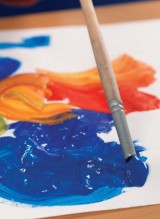 Simple tips to support your children’s experiments with paint…
Simple tips to support your children’s experiments with paint…
• In today’s classrooms, children’s experiences of painting can often be few and far between. If your children need a refresher course, begin by demonstrating the basics of mixing colours and tones, thinning paint with water and using a range of brushes to achieve different effects.
• Rather than patrolling the classroom, try working alongside children, sat at their desks, making your own paintings. Providing them with a running commentary on the challenges you are facing with your own work can encourage them to relax and experiment themselves.
• Responding to children’s artwork during a lesson can be a challenging task for many teachers. The secret is to prompt children themselves to reflect on the next step. Two simple questions: ‘What next?’ and ‘What if?’ are good ways of encouraging children to reflect on ways forward with their work.
• Feed back to the whole class at the end of the lesson, selecting a few examples of children’s paintings to focus on. Encourage children to identify what makes each of the paintings unique, to use specific vocabulary to describe what they can see and to identify how they would like to experiment in the future.
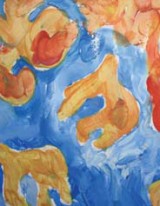 1. Structure and stencils
1. Structure and stencils
The hardest part of creating a spontaneous abstract painting is being spontaneous! Faced with a perfect white rectangle of paper, children can be reluctant to risk spoiling the work before it’s begun. Abstract artists such as Patrick Heron drew inspiration from the natural shapes found in the landscape, and one way of encouraging children to begin their experiments with abstraction is to challenge them to find and draw interesting shapes from the landscape around the school. These shapes can then be cut out and repeatedly drawn around to create dynamic compositions.
For those children who require further support, provide a number of ready-cut shapes to kick-start their compositions; for dynamic designs, encourage children to overlap the shapes, and to have some shapes extending to beyond the edges of the page.
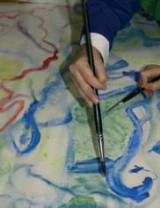 2.Take a line for a walk(in the rain)
2.Take a line for a walk(in the rain)
Artist Paul Klee is credited with the notion of allowing a line to ‘take a walk’, and here the idea is extended a little.Children should begin by brushing a thin layer of clean water across their paper, before painting a long, twisting line from one edge of the paper to another. Immediately they will see that the paint begins to ‘bleed’ into the water, continuing to move after they have made their mark. Encourage children to add further meandering lines from other edges to create spontaneous networks of ‘roads’ and ‘islands’. The wet areas of paint should be allowed to bleed into each other to create new colours and tones, and more water can be brushed on to add further rainfall.
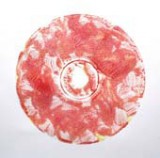 3. Look – no brushes!
3. Look – no brushes!
One way of relinquishing control over the painting process is to abandon brushes. A routine investigation of your recycling bin will remind you that it’s overflowing with objects that can be used to apply paint to paper in unique and intriguing ways. Twenty years ago, the thought of using CDs to create artworks would have seemed hugely extravagant, but today these little silver circles are throwaway items. The discs do, however, offer opportunities to create interesting artworks that encourage children to move beyond the rectangle.
Demonstrate to children how to thin readymixed paint with water, mix a range of tones and brush it across the surface of the CD. Then take a sheet of thin paper such as newsprint, place it across the CD and press gently across the surface, before peeling back the paper to reveal the printed image.
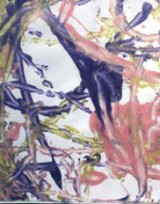 4. Rolling along
4. Rolling along
Jackson Pollock is well-known as the Abstract Expressionist who abandoned his brushes, stretched his canvasses across the floor and poured paint directly from the tin. Now, Pollock’s approach to creating his masterpieces might not be quite what you had in mind for your art lesson this week, but his methods can be easily adapted for use in the classroom.
The key to creating a Pollock-inspired painting is to scale down the process: begin by gathering together some shoeboxes, and cut paper to fit inside each one. Provide children with ready-mixed paint and a number of marbles, before prompting them to think carefully about each of the decisions they are about to make, in terms of the number of marbles, the range of colours in their palettes and so on. The decisions continue when children come to place their marbles on the page – do they roll the box carefully around to create gentle, swirling patterns; or do they slam the shoeboxes shut and rattle the marbles? Either way, when they open the lid to view the results, they need to think again and ask themselves whether the painting is finished – or whether the experiments continue…
Teaching Art and Design 3–11, edited by Sue Cox and Robert Watts, is published by Continuum Books.
Stimulation for Children Funds for Schools Support for Art http://www.apfs.org.uk 0800 027 1939
Help Pupils Tell Fact From Fiction In The Digital World
Ace-Computing
Reorganise your music room
Ace-Music
